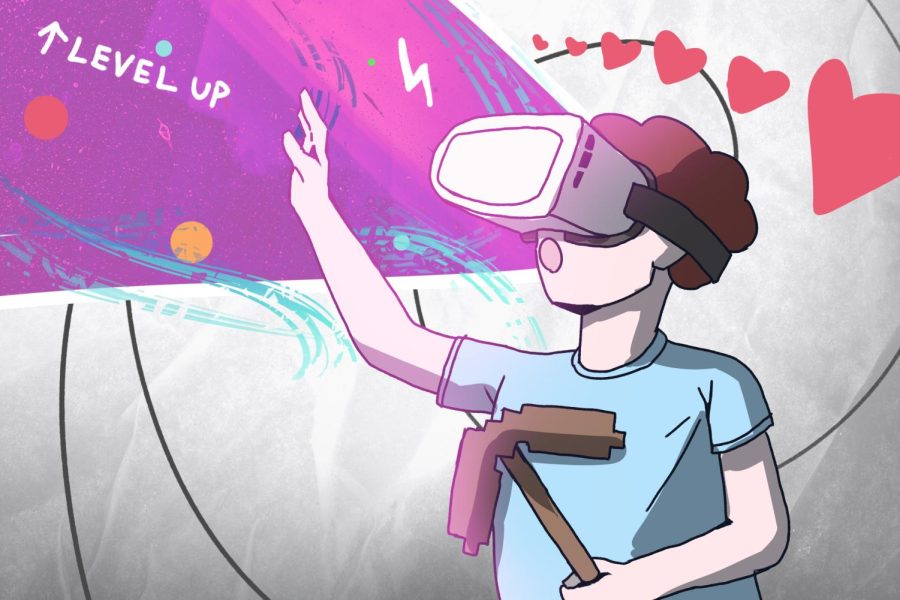Hyperrealism in video games must change
It was the final days of summer when “Black Myth: Wukong” — a new video game taking place in ancient China — entered the spotlight.
June 20, 2023
Video games have been around since the early ’70s when classic games like Pong and Pac-Man dominated the market. 50 years later, technological advancements in storytelling, gameplay and graphics have caused video games to be more popular than ever. The imagination and creativity game developers express when they pour their passion into video games have led to the expansion of stunning visuals and gameplay that keep the gaming community engaged.
Throughout the years, realism within gameplay has become a topic of interest for graphic and game designers. Hyperrealistic gameplay— or gameplay that mimics real life and resembles a highly detailed photograph — eliminates the creativity of game developers, affects gamers’ mental health and should only be used as a foundation for game developers’ creativity instead of for the basis of the game itself.
When Netherrealm Studios’s Mortal Kombat came out in 1992, parents across the nation called for legislative reforms to the video game industry. Their claims that the game was too violent and realistic mirror the concerns of parents in 2023. One of the greatest apprehensions among parents is the narrow bridge between fantasy and reality, which directly affects the primarily young children that play video games.
Many children play hours of violent, life-like video games every day, causing them to be susceptible to aggression and mental health issues. A study by NPD Group found that 71% of children aged 2 to 17 played video games in 2022, increasing by 4% from 2021. This increase in video game usage has caused children to be more likely to be exposed to hyperrealistic content.
In April 2023, Epic Games released “Unreal Engine 5,” an innovative 3D software capable of developing unparalleled detail and lighting in video games. “Unrecord,” a police body-cam shooter game created by “Unreal Engine 5,” has garnered attention within the gaming community due to its hyperrealistic elements.
Controversy arose as clips of the game circulated online, and many became worried that realism had spiraled out of control. With the game’s undeniably life-like landscape and violent gameplay, it’s nearly impossible to tell that the shooting isn’t real.
Alexander Spindler, the creator of DRAMA — the game company that created “Unrecord” — put the rumors to rest. Spindler released proof of actual gameplay through the photorealistic lens to show that “Unrecord” was not body-cam footage made for the game and was instead advanced hyperrealistic graphics, effectively proving the power this new technology has.
With an increase in realism in gaming, children are more likely to be exposed to graphic, life-like violence. When video games parallel real life, some players can easily get caught up in a fake world, potentially leading to a decline in mental and physical health.
Hyperrealism within games pushes users to escape into the fantasy of gameplay and disregard reality. Society is only moving closer to what the writer Ernest Cline envisioned in his book “Ready Player One”: A world consumed by a virtual reality game in which people compete to find an easter egg rather than living out their actual lives.
Constant exposure to video games causes loneliness and mental illness to skyrocket among children and young adults. This phenomenon is only elevated by hyperrealism because of the further detachment from real life. Playing video games every day is correlated with social anxiety, a lack of motivation and depression. These violent hyperrealistic games also desensitize consumers to violence and are linked to aggressive thinking and behavior in youth.
The use of hyperrealism in gameplay also limits the creativity and art styles of game creators. Graphics are an incredibly important tool for getting gamers invested in storytelling or gameplay. Games like “Legend of Zelda” and “Cuphead” are known for their unique animation and style, setting themselves apart from other games.
Video games are a form of art and should represent a magically fabricated view of reality for players. Developers make games to express their innermost imagination, but hyperrealism takes away their creativity by forcing them to mimic the real world. Limiting the imagination of video game designers, standardizing all gameplay. Video games need to give up extreme realism and embrace the styles of gameplay that gained popularity in the first place.
Although realism has its downsides, it can and should have a place in the gaming community. In story-telling games such as “The Last of Us” or “Red Dead Redemption 2,” realism is necessary to immerse players in the story and evoke their emotions. Many photorealistic games can be astonishingly beautiful with breathtaking sights and captivating gameplay. These games are necessary for the gaming industry, but they should be used as a vessel to express greater creativity with advancing technology instead of standardizing all gameplay.
As realism becomes more common within the video game industry, recent games have explored this newfound technology and used it in interesting ways. By adding unique style to realistic settings, games can engage audiences like never before, flipping the generic nature of hyperrealism on its head. Games like “Ghost of Tsushima” and “Cyberpunk 2077” have allowed game developers to express creativity with the baseline of realism at its front. Hyperrealism, while flawed, can be implemented correctly within video games as long as developers keep the style fresh and continue to innovate.











